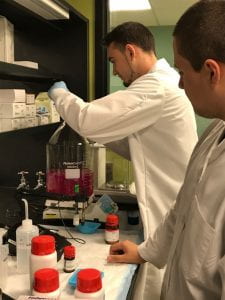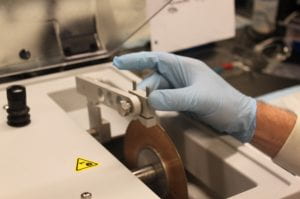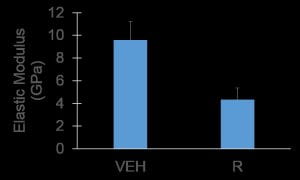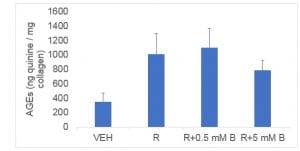Research in Bioengineering
Investigation of In Vitro Vitamin B6 Treatment to Reverse Deterioration of Bone Mechanical Properties
By Jacob Aaronson
In the summer of 2017 I was granted a grant from the OUR to join Bioengineering Professor Dr. Lamya Karim’s lab and worked alongside undergraduate Bioengineering student John Riordan to conduct a research project concerning the testing of the properties of bone that were placed in a simulated diabetic environment. This was an interdisciplinary project that allowed us to work with techniques from bioengineering, mechanical engineering, biochemistry, and biology. Ever since I took a class in Biomechanics in the third year of undergraduate studies, I have been interested in exploring the mechanical properties of human body tissues such as bone. Through this OUR-funded project, I exercised this interest through hands on research and design.

Portrait of Jacob Aaronson
From previous research it has been found that patients with type 2 diabetes mellitus have an increased risk of bone fracture compared to non-diabetics [1]. These patients have normal or high bone mass, which is typically beneficial for bone. This suggests factors other than bone mass, such as changes in bone quality, may play an important part in diabetic fractures. In this study, I looked at a possible method to inhibit harmful protein crosslinks that can accumulate in diabetic patients. I chose Vitamin B6 as the inhibitor because it showed promising results in rat bone [2]. However, it has never been tested in human bone. With this fact in mind, the goal of this project was to look at changes in protein crosslinks and mechanical properties of bone specimens after being placed in a simulated type 2 diabetic environment and to test how Vitamin B6 might prevent these changes.

Jacob Aaronson (Back) and John Riordan (Front) making solutions for incubation of cortical bone specimens
§
In the first part of this project, my main task was to work with human donor bone (tibias or “shin bones”) that I cut and polished down to small testable sizes. I used a low-speed diamond blade saw and polishing machine to accomplish this task. Once all the specimens were ready, we then incubated them in control and type 2 diabetic environments (a chemical solution with ribose sugar) with and without Vitamin B6. The bone samples were incubated in these solutions for 10 days at 37ºC with pH maintained between 7.2-7.6 to represent the human body environment.

Diamond blade saw used to cut bone beams
The second part of this project involved gathering data on the incubated bone specimens. When first looking at the post incubation samples, we saw a significant difference in color between ribose and control groups. Samples in ribose solutions were brown, which indicates a buildup of the protein crosslinks. Meanwhile control groups had no significant color change. A biochemical assay was run to measure the crosslink content, and cyclic reference point indentation (RPI) tests were used to measure the mechanical properties of bone after incubation.

Cortical beams treated with ribose (top) and cortical beams treated with no ribose or vehicle group (bottom)
From the data, we did not detect our expected differences in crosslinks or mechanical properties between the Vitamin B6 treated group compared to the non-treated group. This may be due to our small sample size and/or the Vitamin B6 dose being too low. Although we did not detect any differences from the hypothesized inhibitory effects of Vitamin B6, we did have other key findings:
- In vitro incubation with ribose does increase AGEs (protein crosslinks) in human cortical bone
- Indentation tests showed there were deteriorated bone mechanical properties in a simulated diabetic state
- Bone specimens with higher crosslink contents had weaker mechanical properties

There was a trend for higher indentation distance (represnting weaker mechanical properties) and significantly more crosslinks in the ribose treated group (R) compared to vehicle controls (VEH).
By continuing my work with the mechanical engineering department, more mechanical testing data was derived from the incubated cortical beams. Specifically, we performed microindentation tests on the samples to measure bone stiffness.


Samples treated with ribose had a lower elastic modulus (measure of stiffness) compared to the control group. This trend was seen across all age groups (57-87 years).
We also carried out another incubation of cortical beams to test the efficacy of different concentrations of Vitamin B6 combined with the same concentration of ribose. The small dose of Vitamin B6 used in the previous incubation appeared to have no effect on AGE inhibition so we decided to increase this parameter. Vitamin B6 concentrations of 5.0 mM and 50 mM were used due to their positive effects seen in a previous study [3].

Results from the most recent incubation where two different concentrations of Vitamin B6 were used (0.5 mM and 5 mM). The 5 mM concentration seems to have a considerable effect on the number of AGEs when compared to the ribose treated group (R).
Since the 5 mM concentration shows promising results it is important to verify this in future studies. Therefore, the next step of this project is to confirm the correct amount of Vitamin B6 through additional incubations followed by mechanical testing, chemical testing, and structural analysis. Specifically, we would like to carry out bending tests because they will give a more complete understanding of how the mechanical properties of samples change after incubation. We also plan on measuring specific AGEs, such as pentosidine, in our assays so that we can analyze the exact AGE chemical structures that are forming. Lastly, we hope to apply imaging techniques such as microCT analysis in order to measure microdamage in samples. A long-term goal for this project is to utilize our accumulated understanding of Vitamin B6 on the inhibition of AGEs in vitro to establish reason for animal model testing.
From this experience, I have learned that research projects require countless amounts of planning, organization, and collaboration. I am thankful that I have developed these types of qualities during my time as an undergraduate researcher. My plan is to apply this research experience to graduate school, industry, and everyday life. Working on projects that are aimed to help restore health to many people will be something I always find highly motivational and invaluable.
I would like to thank the Office of Undergraduate Research for presenting me with this highly sought-after opportunity. I would also like to thank Dr. Lamya Karim, Rachana Vaidya, Taraneh Rezaee, Kelly Merlo, John Riordan, and the Mechanical and Civil & Environmental Engineering departments for all the help carrying out this project.
References
[1] Janghorbani et al (2007), “Systematic Review of Type 1 and Type 2 Diabetes Mellitus and Risk of Fracture,” American Journal of Epidemiology 166 (5/1). doi.org/10.1093/aje/kwm106
[2] Saito, M., Fujii, K., Mori, Y., & Marumo, K. (2006), “Role of collagen enzymatic and glycation induced cross-links as a determinant of bone quality in spontaneously diabetic WBN/Kob rats,” Osteoporosis International 17(10). doi:10.1007/s00198-006-0155-5
[3] A. Ashley Booth, Raja G. Khalifah‡, Parvin Todd, and Billy G. Hudson. “In Vitro Kinetic Studies of Formation of Antigenic Advanced Glycation End Products (AGEs),” The Journal of Biological Chemistry 272 (9). Pp. 5430–5437, 1997.

